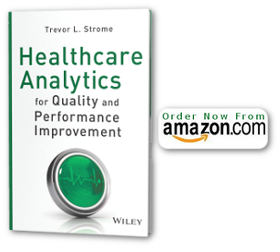Why shouldn’t every Business Intelligence (BI) dashboard and report be a tour de force, showcasing the skills of the BI developer and capabilities of the technologies used? As BI developers become more skilled, and BI systems become more feature-filled, there is the danger of “showing off” and, ultimately, reducing the impact that BI has on decision-making.
Healthcare executives, managers, and staff are busy just keeping up with everyday operations and management. The BI dashboards and reports that are developed for them must help achieve their goals by providing accurate and timely information in an accessible and intuitive format. There is no place for elements of a dashboard or report that do not directly contribute to a better understanding of the operation.
Connecting with the End User
Advice that is commonly given to authors is, “don’t write for other authors – write for your audience.” If an author tries to impress other writers (such as by showing off skill, wit, or technique) rather than the intended audience, the work will invariably fall short of spectacular. On the other had, if an author writes to address the needs, desires, and expectations of the intended audience, there is a much greater chance of the work “connecting” in a meaningful way with the readers.
The same advice applies to developers of business intelligence and analytics applications. Many BI developers are naturally creative, analytical, like to innovate, and enjoy a little friendly competition. Many developers (myself included!) will scrutinize and learn from what work others have done, and try to improve on it within their own development efforts. Don’t get me wrong – this is how innovation occurs! Without trying new approaches, tools, and designs, the field of BI and analytics would not have progressed as far as it has.
More Data and New Gadgets – Not Always Better
Despite continued advances in developer skill and system capabilities, BI applications such as dashboards, cubes, and other reports must be crafted to meet the needs of the end-user, not to impress other BI developers.
Providing users with more data than is currently required or can be utilized will only overwhelm them with too much information. And, adding too many fancy “gadgets” or cramming too much onto a screen or report will cloud the intended message. Remember that not all “enhancements” to BI systems actually improve the clarity of information being presented (think 3-D gauges)!
Finally, applying analytical or statistical techniques beyond end-users’ current sophistication level will make the data too difficult to understand and may lead to incorrect interpretation of data.
Prototyping to Innovate
When there is something new that I want to try (such as a gadget or statistical technique), I will build a prototype of the dashboard, report, or other application and review it with several of the key stakeholders. This way, I can improve the design based on the advice and knowledge of subject matter experts and people who will be using the end-product. This allows us to determine what additional educational efforts will be necessary to ensure end-users have the necessary skills to properly interpret and utilize the new tool or report.
Like most other technological endeavors, healthcare BI is evolving quickly and may out-pace the technological sophistication of end-users. By understanding the audience (or end-user), innovations in BI can be incorporated into healthcare BI end-products such as dashboards and reports as long as the clarity and usefulness of presented information is not negatively impacted.

{ 0 comments… add one now }